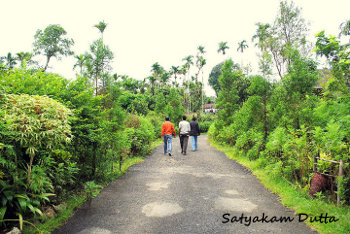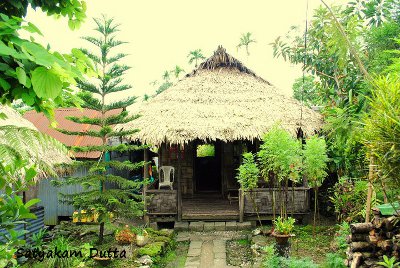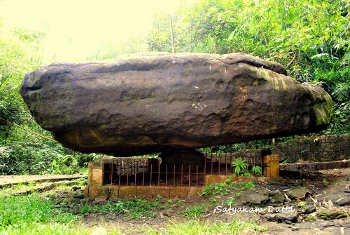Clean Village Mawlynnong and Border Town Dawki
November 1, 2010My first trip after coming to Shillong, Meghalaya was to Mawlynnong and Dawki. It was the month of September and the climate had been wet but had become cooler. Let me first write a few lines about both these places.
Mawlynnong is widely regarded as the cleanest village in Asia. However, many people have apprehensions regarding the claims. We Indians, generally take a lot of pride in self proclaimed and self anointed degrees for ourselves and skeptics believe that Mawlynnong’s is one of them. But seeing the pristine beauty and the highest degree of cleanliness in the village I can say that it is the cleanest village I have ever seen and we seriously need to replicate the same in the villages all across India. If a village in remote Meghalaya can achieve such a feat why not anywhere else. Nestled in the pristine hills of Meghalaya, the hamlet has over 80  houses and the villagers, despite their daily schedule of farming and cultivating broomsticks, have worked hard to earn this distinction.
houses and the villagers, despite their daily schedule of farming and cultivating broomsticks, have worked hard to earn this distinction.
Dawki is on the border of Meghalaya with Bangladesh. Its on a hill and we can see the plains of Bangladesh all along the route to Dawki. It is in East Khasi Hills and it has the Dawki Bridge, a suspension bridge over the Dawki river. It was constructed in 1932 by the Britishers. However it is dangerous to take snaps of the bridge as it is of strategic military interest. Dawki is a small town with very few shops. The border of Bangladesh lies at a distance of 2 kms from Dawki town.
 Our journey started at 8.30 am in the morning with a call from our driver Anil ji waking us up at 8.00 am, the scheduled time of departure. We hurriedly had ourselves freshened up and started our journey without much delay. Dawki is towards south of Shillong and on the way we find the road to Cherrapunjee too, which cuts on the right. The road to Mawlynnong also lie on the right. After crossing the helipad at Shillong, we rise up another hill and with curvy roads we reach the bridge on the right of which a road cuts its way to Cherrapunjee. From the top of the hill the road to Cherrapunjee can be seen for a long time, but since clouds had engulfed us from all sides we hardly had a visibility of 50 meters.
Our journey started at 8.30 am in the morning with a call from our driver Anil ji waking us up at 8.00 am, the scheduled time of departure. We hurriedly had ourselves freshened up and started our journey without much delay. Dawki is towards south of Shillong and on the way we find the road to Cherrapunjee too, which cuts on the right. The road to Mawlynnong also lie on the right. After crossing the helipad at Shillong, we rise up another hill and with curvy roads we reach the bridge on the right of which a road cuts its way to Cherrapunjee. From the top of the hill the road to Cherrapunjee can be seen for a long time, but since clouds had engulfed us from all sides we hardly had a visibility of 50 meters.
After crossing some hills we reach a plain area surrounded by hills. Most hills on the way were connected by the road with small bridges and it was a great feeling when we realised that we were crossing from one hill to the other. The plain area was very beautiful and had many curves on the road. There were a lot of cattle and goats grazing on the plains which was mostly covered with grass. The scenic beauty of that area was next to nothing in the entire journey.
At around 12.00 noon we reached the place from where a right on the right would lead us to Mawlynnong. Then started the vuvuzelic sound of crickets and other insects which continued throughout the entire time we remained in that area. The road to Mawlynnong was narrow and green on both sides. However the road was good unlike most village roads in this part of the country. The distance from the diversion we took to Mawlynnong was 18 kms. We reached the village at around 1 pm was was amazed by the beauty of the place. There were beautiful gardens in all the houses with various varieties of flowers. The roads were very clean and every bit of the road was all-weather. The smaller roads within the village were made of concrete. In front of every house and shop, there were beautiful bamboo baskets as dust-bins. The hotels in the village do not serve any ready-made dish, they needed to be ordered. However we found a nice tea-stall who served us cakes and puffs.
The distance from the diversion we took to Mawlynnong was 18 kms. We reached the village at around 1 pm was was amazed by the beauty of the place. There were beautiful gardens in all the houses with various varieties of flowers. The roads were very clean and every bit of the road was all-weather. The smaller roads within the village were made of concrete. In front of every house and shop, there were beautiful bamboo baskets as dust-bins. The hotels in the village do not serve any ready-made dish, they needed to be ordered. However we found a nice tea-stall who served us cakes and puffs.

The Tea stall where we had Tea 7 Snacks
After having our snacks we went to a place where the village folks have built an elevated platform atop a tree from where we can see the entire village. The stairs were made of bamboo
 and were tied to a tree. We went to the top of the staircase to the platform but as there was a lot of fog all around we could not have a clear view of the village from there. However we were delighted by the prospect of the bridge and platform made of bamboo.
and were tied to a tree. We went to the top of the staircase to the platform but as there was a lot of fog all around we could not have a clear view of the village from there. However we were delighted by the prospect of the bridge and platform made of bamboo.
We then returned to the central area of the village where our cars was parked. Anilji started our journey back from the village. A few kilometers away we arrived at a junction where the villagers had told us that a living root bridge existed. We took the small road which went down through rocky stairs. Only a 50 steps below lied a beautiful living root bridge perhaps 300-400 years old. We were  astounded to see the bridge. There were two trees which had their roots over a small stream passing by in such a way that people could travel over the roots to the other bank of the stream thus making it a bridge. The villagers had told us that their ancestors had mastered the art of making living root bridges and they have lot of them in and around the Cherrapunji region.
astounded to see the bridge. There were two trees which had their roots over a small stream passing by in such a way that people could travel over the roots to the other bank of the stream thus making it a bridge. The villagers had told us that their ancestors had mastered the art of making living root bridges and they have lot of them in and around the Cherrapunji region.
While in the village, we heard that there was a place where lied two stones – one small and one big, the big stone lied balanced over the small one just near the village. But while going to see the living root bridge we did not see the same. We decided that we would go back towards the village and try to find if the stones actually existed. Finally on the left towards the village we saw a small gate which led to the place where the two stones lied. It was a great experience to see the big rock balancing over a small stone. The North-East of India offers us similar surprises but most of such surprises remain unmarked much like these two stones. There was no signboard stating the same near them and we had to keep a stringent eye on the surroundings to find them.
the village and try to find if the stones actually existed. Finally on the left towards the village we saw a small gate which led to the place where the two stones lied. It was a great experience to see the big rock balancing over a small stone. The North-East of India offers us similar surprises but most of such surprises remain unmarked much like these two stones. There was no signboard stating the same near them and we had to keep a stringent eye on the surroundings to find them.
We then decided to bid farewell to them and started our journey to Dawki. In 30 mins we reached the place where we took a left towards Dawki. I forgot to mention the number of butterflies I saw on the way to the village and back. I have never seen such number of butterflies together. Later I heard a story of a couple who decided to have their marriage ceremony in the jungles of this region, somewhere. In their reception they were sort of attacked by a large herd of butterflies whose wing spans were larger than a handfan. The guests in their reception had a feast of eyes to see the vibrant colors all over the place.

The road to Dawki is curvy and topsy turvy. However the roads are well maintained primarily because the road is very crucial for Indo-Bangla trade. In another 30 mins we reached a place in the hill where we can see the Bangladeshi plains. We reached Dawki in 15 mins from there. Dawki is a very small town and had very few shops. We saw the Dawki Bridge on the way. We reached the border at around 3 pm. We took a lot of snaps in and around the border. There were Children who were playing in the no man’s land. The police  did not bother about them. Probably they did not bother about the borders at all.
did not bother about them. Probably they did not bother about the borders at all.
We then went back to the Dawki town and had tea and snacks in a small stall. I searched for signals in my mobile phone and saw it catching signals of 4 Bangladeshi TSPs, while it did not have Airtel signal at all.
On our way back the sky had cleared and we travelled through the plains and hills and were spellbound by the beauty which Mother Nature has bestowed on Meghalaya. The picture I took and the moments I spent, stopping the car every now and then to enjoy the beauty, I shall treasure those moments all my life.
Mawlynnong, I shall come back soon to you, with more people, to share your story to the world.
We welcome your comments at letters@friedeye.com

I like . this
Excellent piece of writing with eye catching photographs. Can you please tell me what is the distance between Dawki and Sylhet? Myself and my wife are residents of Guwahati and we are eager to visit Sylhet which happens to be the place of birth of my parents. We do possess valid Passports and would take visa once we are able to finalise the dates of our visit. I shall be tankful if you could also enlighten me as to how I can go to Sylhet from Dawki by road and where Can I stay during my svisit there.
very nicely described.. ur style of narration is quite like mine.. with time, distance n the niceties of the travel undertaken.. with a zest of both exploring the place n laying it in front of the world to lap it up.. i had seen the pics u had posted.. words add another dimension.. i had no idea u write blogs too.. while researching about the indo-bangladesh border skirmish of 2001 i came across ur blog on google.. had the slightest of idea it would be urs.. good one.. really..
Lekhata khub bhalo laaglo and so the pics you have taken. Daroon. Thanks. Sudhu Mawlynnong er je Bamboo sky road ta, sekhane ekta tree house o ache. Ekta foreign blog e dekhlam. Setay thakar byabostha kichu ache kina jante parle khub bhalo lagto. Thank you againg.
Thank you 🙂
the big rock on the small rock looks exciting. The church looks picture perfect. N-E has a high potential for tourism industry…
[…] This post was mentioned on Twitter by Fried Eye, Fried Eye. Fried Eye said: Clean Village Mawlynnong and Border Town Dawki http://goo.gl/fb/7Wiw2 #issue21 #issues #seenew #spices #type2 #voli […]